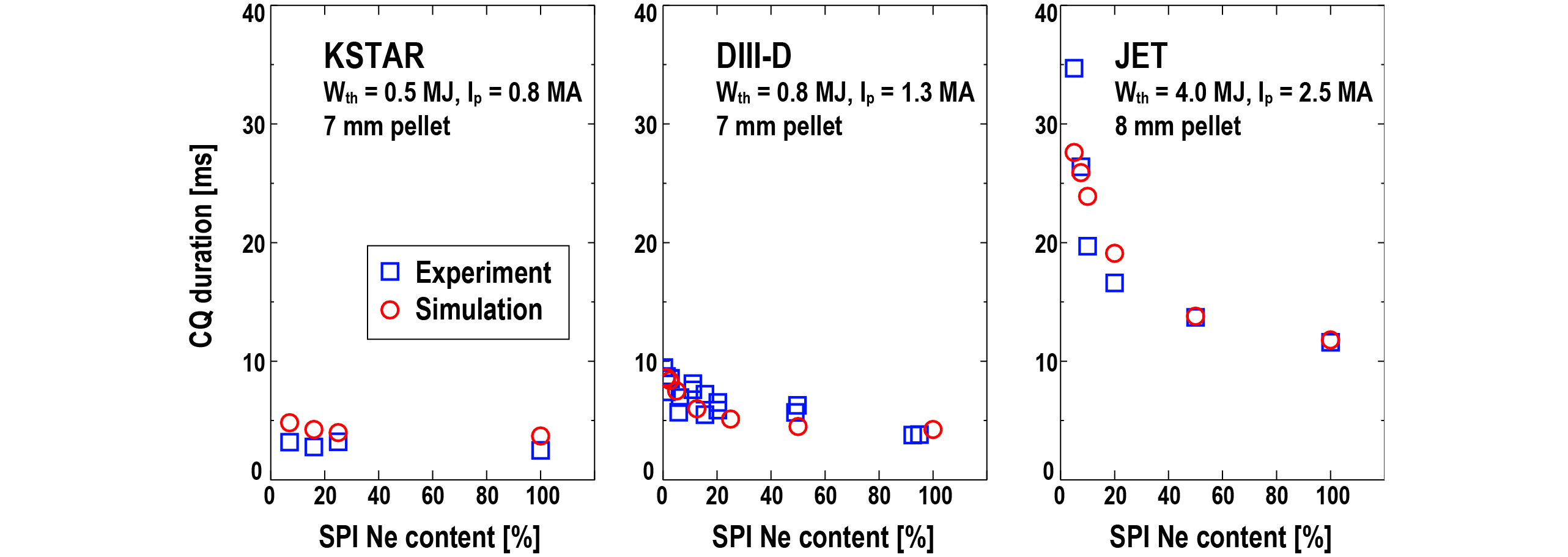Speaker
Description
New scaling laws and modeling, developed at DIII-D and benchmarked with data from JET and KSTAR, provide a path for projecting Shattered Pellet Injection (SPI) performance to ITER, while improved understanding of higher-order effects such as asymmetries better constrain the expected behavior. In the limit of radiative shutdown by high-Z impurity injection, the volume-averaged performance of disruption mitigation by SPI can be largely understood through global energy balance, without consideration of magnetohydrodynamic (MHD) effects. Particle assimilation rates are quantitatively predicted, with good agreement between simulation, empirical scalings, and a large database of experimental measurements (Figure 1). Dual-SPI shutdown characteristics (with two injectors at two different ports) are also well captured by simulations based on the energy-balance model, including additional density rise due to added deuterium. Radiation asymmetries due to the rapid and localized SPI particle source are experimentally observed, but current estimates of the peaking factor remain below ITER limits. For runaway electron (RE) mitigation, pure argon SPI is able to completely dissipate fully-avalanched post-disruption RE beams. These results provide a basis for optimizing injection scenarios for the ITER disruption mitigation system.

New simulations show that the global evolution of the SPI shutdown is primarily governed by energy balance, rather than by MHD effects, with good agreement found with data from DIII-D, JET, and KSTAR experiments. The SPI shutdown is modeled through modification of the 0D KPRAD code {1}, which tracks volume-averaged energy balance during the disruption, incorporating a particle source determined by the shielding-limited species-dependent ablation {2} of the shattered pellet plume. A large collection of thermal quench (TQ) and current quench (CQ) characteristics observed in experiments are explained through robust agreement with simulations based on this model (Figure 1). Particle assimilation rates are quantitatively predicted by these simulations, and compare well with measured densities across a large database of SPI shots. The resulting CQ rates in all three devices are accurately predicted, as the mixture of high-Z and low-Z injection species is systematically varied (Figure 2).

Empirical regression scalings, which are a function of pre-SPI plasma parameters, also successfully reproduce measured CQ densities in DIII-D (Figure 1, right). The dependence of the assimilation primarily on global plasma parameters is consistent with the modeling assumption that energy-balance plays a dominant role in the process (although possible hidden variables, evidenced by a small number of outliers, are under study). Electron temperature is found to be the dominant dependence for early assimilation of the shattered pellet, while Ohmic dissipation of the poloidal magnetic energy is important later for sustaining the ionization of the CQ plasma. Both of these quantities are expected to increase favorably for ITER (towards higher density), although scaling with device-size has not been considered (and will tend towards lower density).
The behavior of dual-SPI shutdowns (with two injectors from two different ports) {3} is also well captured by the 0D KPRAD simulations, indicating that 3D effects related to the multiple injection locations play a lesser role. In particular, the ability of additional deuterium to further raise the density (over pure neon SPI) is quantitatively matched by simulation, as is the measured impact on neon assimilation {3}. These results suggest that 3D effects do not have a significant impact on the globally averaged mitigation, and are instead important primarily for heat load asymmetry effects.
Such peaking of heat loads due to TQ radiation asymmetries is detected experimentally in DIII-D, but current estimates of the peaking remain below ITER limits (Figure 3). The asymmetries are broadly centered on the injection port, and are due to the rapid and localized SPI particle source (in contrast to MHD-driven asymmetries during massive gas injection). The toroidal peaking factor (TPF) is estimated from comparisons with ray tracings of various TQ emissivity profiles, and the current estimated value of 1.33 remains below ITER limits (TPF<2). However, refinements of these estimates by separately considering the TQ and CQ heating may lead to higher values.

For the mitigation of REs, pure argon SPI (enabled by a new mechanical punch) is able to completely dissipate centered post-disruption RE plateaus in DIII-D, in contrast to previous neon SPI which was accompanied by a deuterium ‘shell/grease’ layer {4}. This supports the picture that injection species is the dominant factor determining the effectiveness of ‘second injection’ for RE dissipation (rather than gas/pellet form), and suggests that upper port plugs in ITER with a higher-bend-angle shatter tube may be effective for this application. RE current dissipation due to argon and neon SPI, albeit partial, is also observed at JET.
This DIII-D research, in collaboration with the JET and KSTAR SPI programs, continues to expand SPI physics understanding and to improve projection of these results to ITER. The newly developed scalings and simulations provide guidance for future experimental and leadership-class-computational studies, and provide a path for extrapolating SPI performance beyond a single device, towards ITER.
{1} D.G. Whyte, et al., Journ. Nucl. Mater. 313 (2003) 1239
{2} P.B. Parks, 7th Annual Theory and Simulation of Disruptions Workshop (2017) Princeton, USA
{3} J.L. Herfindal, et al., Nucl. Fusion 59 (2019) 106034
{4} D. Shiraki, et al., Nucl. Fusion 58 (2018) 056006
Work supported the US DOE under DE-FC02-04ER54698, DE-AC05-00OR22725, DE-FG02-07ER54917, and DE-AC52-07NA27344, and by the ITER Organization (TA C18TD38FU) and carried out within the framework of the EUROfusion Consortium, receiving funding from the Euratom research and training programme 2014-2018 and 2019-2020 under grant agreement No 633053. Views and opinions expressed herein do not necessarily reflect those of the European Commission.
| Affiliation | Oak Ridge National Laboratory |
|---|---|
| Country or International Organization | United States |
